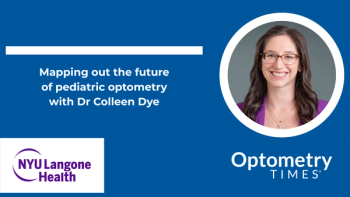
- September/October digital edition 2025
- Volume 17
- Issue 05
Empowering patients, preserving vision
The vital role of dialogue and education in managing glaucoma.
Glaucoma is a complex disease requiring lifelong management. Historically, management starts with IOP control using topical antiglaucoma medications. These medications require both daily and long-term adherence and can significantly impact disease progression. The consequences of untreated or poorly managed glaucoma can have a debilitating outcome on both vision and quality of life. As health care providers, it is essential that we expand the dialogue with our patients with glaucoma for successful treatment outcomes.
Glaucoma is a multifactorial, progressive, neurodegenerative disease that constitutes the most frequent cause of irreversible blindness.1 It is estimated that approximately 3 million Americans are currently being treated for glaucoma, and that number is expected to reach 6.3 million by 2050.2 Additionally, the number of people with glaucoma is estimated to reach approximately 111 million by 2040 due to the aging population.1 The chronic and degenerative nature of glaucoma calls for long-term, often lifelong treatments to manage ocular hypertension, slow optic disease progression, and, ultimately, preserve vision for as long as possible.3 As antiglaucoma medication has traditionally been the first-line treatment, it is inherent that optometrists and their patients get the most out of these topical glaucoma therapies. Adherence with glaucoma medications is a fundamental problem in the care of patients with glaucoma, as up to 50% of patients fail to receive the intended benefit of the treatment.4 Research has identified many barriers to patients’ adherence, from factors depending on the type of medication administered, communication between the physician and patients, and patients’ behavior and lifestyle.4
The role of optometrists in glaucoma management
As primary eye care providers, optometrists play an essential role in the diagnosis and management of glaucoma from early detection and diagnosis to treatment, routine monitoring, and follow-up care. Treatment and treatment regimens will change over the course of a patient’s lifetime, with most patients being treated with more than 1 medication simultaneously.5
It has been well established that patient adherence declines with polypharmacy,4,6 and in the case of ocular diseases such as glaucoma, that adherence can further be impacted by topical therapy adverse effects such as conjunctival hyperemia and ocular surface discomfort. In fact, nonadherence with the topical therapy regimen has been reported in up to 30% of patients with glaucoma, and this number doubles in patients using preservative-containing drops.3
Further complicating management and adherence is the surreptitious nature of glaucoma. As a painless and slow-
progressing condition, patients may not experience any immediate untoward signs or symptoms when halting or decreasing the frequency of antiglaucoma drop administration. In fact, patients may associate decreasing or halting antiglaucoma drops with greater comfort from the reduced conjunctival hyperemia, burning, and stinging.
Nonadherence rates range from 40% to 72%, and approximately half of patients with glaucoma demonstrate incorrect eye drop technique.6 Patients are unlikely to experience the clinical benefits of their glaucoma medications if they do not adhere to their medication regimen and/or do not instill their eye drop(s) correctly. Positive reinforcement and encouragement from eye care providers may be the most important factor for improving adherence and patient outcomes. This early and repeated communication is vital to improving behavioral and clinical outcomes for patients with glaucoma.
Improving adherence through dialogue, information sharing, and patient empowerment
Antiglaucoma drops are often the first line/mainstay of glaucoma treatment, and it is crucial for optometrists to build trust and a rapport to set their patients up for success with these medications. Open-ended questions and practiced talking points lead to effective doctor-patient communication, ensuring patients feel empowered and well equipped to manage their disease. Building this trust can facilitate communication and foster an environment where patients feel more open to sharing their concerns and more open to advice and instructions, which is vital when delivering complex diagnoses and discussing sensitive treatment options.7 This involves being proactive, making patients aware that there are treatment options if adverse effects occur, and communicating effectively to understand their needs.
Constructive communication is both verbal and nonverbal and includes demonstrating drop instillation techniques and reviewing sanitary practices and punctal occlusion methods while utilizing patient-friendly language. Offering nonjudgmental, constructive feedback while providing positive reinforcement is a recommended tactic.8 For follow-up visits, allow enough time during the exam to encourage and empower patients by asking questions and repeating instructions. Supply those instructions in writing for further reinforcement and reiterate the direct benefits of treatment protocols when they are not obvious to the patients. Discuss how a patient should proceed with missed dosing or supply concerns.
Positive reinforcement, tackling adherence-related barriers as a doctor-patient unit, and educating patients about adherence while obtaining their input into their treatment plans are all proven methods for obtaining successful treatment outcomes.6 Studies have shown that patient adherence increases when physicians educate their patients on how to administer their drops.9
Additional methods to manage or avoid adverse effects of ocular medicines are also advisable to gain adherence. Optometrists assess the ocular surface on a regular basis, and both clinical and experimental studies show that the long-term use of topical drugs may induce ocular surface changes. These range from, but are not limited to, ocular discomfort, tear film instability, conjunctival inflammation, subconjunctival fibrosis, epithelial apoptosis, corneal surface impairment, and the potential risk of failure for further glaucoma surgery.10
It is advisable to use preservative-free solutions whenever possible, but especially in patients with high dosing or prolonged treatment, in those suffering from preexisting or concomitant surface diseases, and those experiencing adverse effects related to the ocular surface.10 Communicating ocular findings, managing signs and symptoms, adjusting medications as appropriate, and managing patient expectations are key to continued treatment adherence. However, as eye care professionals, it is also important that we maintain a consistent and open dialogue with our patients that extends beyond the initial diagnosis.
Eyes on the future
The importance of dialogue between optometrists and patients with glaucoma cannot be emphasized enough. If a patient does not understand the role or impact of their antiglaucoma medication, they have little incentive to continue treatment. However, if a patient does not feel comfortable or confident in our ability to manage their condition, they have less incentive to return for follow-ups, possibly resulting in delayed treatment and/or significant disease progression.
This is a call to action for eye care professionals to prioritize open communication with patient education and to actively encourage patients to participate in discussions about their eye health. Optometrists’ actions today will make a difference to patients with glaucoma in the long term by enhancing earlier detection and increasing medication adherence. In turn, these early steps will work to reduce the burden on our health care system. Dialogue plays a critical role in this journey, and it’s important to remember that behind every glaucoma diagnosis is a person trying to make sense of a new reality while preserving their vision and ocular health.
We believe that prioritizing open communication can preserve the vision and quality of life of our patients. Presenting the patient with treatment options is not only empowering but also effective in achieving outcome measures while strengthening the doctor-patient relationship.
References:
Baudouin C, Kolko M, Melik-Parsadaniantz S, Messmer EM. Inflammation in glaucoma: from the back to the front of the eye, and beyond. Prog Retin Eye Res. 2021;83:100916. doi:10.1016/j.preteyeres.2020.100916
Anspaugh M. How to get the most out of topical glaucoma therapies. Optometry Times. February 13, 2024. Accessed September 12, 2025. https://www.optometrytimes.com/view/how-to-get-the-most-out-of-topical-glaucoma-therapies
Harasymowycz P, Hutnik C, Rouland JF, et al. Preserved versus preservative-free latanoprost for the treatment of glaucoma and ocular hypertension: a post hoc pooled analysis. Adv Ther. 2021;38(6):3019-3031. doi:10.1007/s12325-021-01731-9
Zaharia AC, Dumitrescu OM, Radu M, Rogoz RE. Adherence to therapy in glaucoma treatment-a review. J Pers Med. 2022;12(4):514. doi:10.3390/jpm12040514
AAO and AGS statement on glaucoma eye drop availability – 2014. American Academy of Ophthalmology. January 2014. Accessed September 12, 2025. https://www.aao.org/education/clinical-statement/aao-ags-statement-on-glaucoma-eye-drop-availabilit
Aremu TO, Oluwole OE, Adeyinka KO, Schommer JC. Medication adherence and compliance: recipe for improving patient outcomes. Pharmacy (Basel). 2022;10(5):106. doi:10.3390/pharmacy10050106
Carpenter DM, Tudor GE, Sayner R, et al. Exploring the influence of patient-provider communication on intraocular pressure in glaucoma patients. Patient Educ Couns. Published online July 6, 2015. doi:10.1016/j.pec.2015.07.001
Berdahl JP. Building patient confidence through constructive communication. Glaucoma Today. September/October 2024. Accessed September 12, 2025. https://glaucomatoday.com/articles/2024-sept-oct/building-patient-confidence-through-constructive-communication
Sleath B, Blalock SJ, Carpenter DM, et al. Ophthalmologist-patient communication, self-efficacy, and glaucoma medication adherence. Ophthalmology. 2015;122(4):748-754. doi:10.1016/j.ophtha.2014.11.001
Baudouin C, Labbé A, Liang H, Pauly A, Brignole-Baudouin F. Preservatives in eyedrops: the good, the bad and the ugly. Prog Retin Eye Res. 2010;29(4):312-334. doi:10.1016/j.preteyeres.2010.03.001
Articles in this issue
about 1 month ago
What a pharmaceutical representative taught me about glaucoma dropsabout 1 month ago
AI glasses fill in gaps for patients with low visionNewsletter
Want more insights like this? Subscribe to Optometry Times and get clinical pearls and practice tips delivered straight to your inbox.



















































.png)


